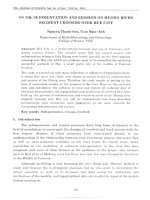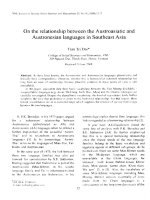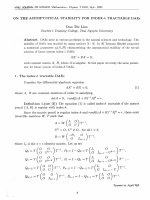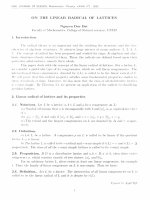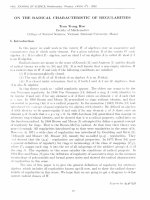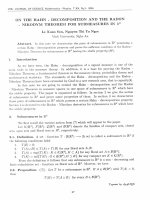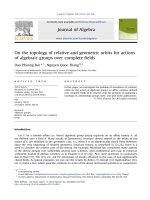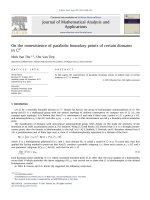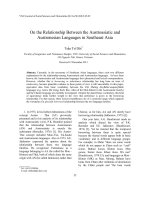DSpace at VNU: On the martingale representation theorem and approximate hedging a contingent claim in the minimum mean square deviation criterion
Bạn đang xem bản rút gọn của tài liệu. Xem và tải ngay bản đầy đủ của tài liệu tại đây (1.37 MB, 12 trang )
VNU Joumal of Science, Mathematics - Physics 23 (2007) 143-154
On the martingale representation theorem and approximate
hedging a contingent claim in the minimum mean square
deviation criterion
Nguyen Van H uu1 % Vuong Quan Hoang2
1 Department o f Mathemaíics, Mechanics, Informatics, College o f Science, VNU
334 Nguyen Trai, Hanoi, Vìetnam
2ULB Belgìum
Received 15 November 2006; received in revised form 12 September 2007
A b s tra c t. In this work vve consider the problem of the approximate hedging of a contingent
claim in minimum mean square deviation criterion. A theorem on martingaỉe representation in
the case of discrete time and an application of obtained result for semi-continous market model
are given.
Keyxvords: Hedging, contingent claim, risk neutral martingale measure, martingale representation.
1 . Introduction
The activity of a stock market takes place usually in discrete time. Uníòrtunately such markets
with discrete time arc in general incomplete and so super-hedging a contingent claim requires usually
an initial price two great, which is not acceptable in practice.
The purpose of this vvork is to propose a simple method for approximate hedging a contingent
claim or an option in minimum mean square deviation criterion.
Financiaỉ m arket modeỉ with discrete time:
Without loss of generality let us consider a market model described by a sequence of random
vectors {5n> n = 0 ,1 ,..., N }y sn e R dy which are discounted stock prices defined on the same
probability space {n, s , p } with {F„, n = 0 ,1
being a sequence of increasing sigmaalgebras of information available up to the time n, vvhereas ”risk free ” asset chosen as a numeraire
sĩ= 1.
A F^-measurable random variable H is called a contingent claim (in the case of a Standard call
option H = max(S„ —K , 0), K is strike price.
Corrcsponding author. Tel.: 84-4-8542515.
E-mail: huunv@ vnu.edu.vn
143
144
N.v. Huu, V.Q. Hoang / VNU Journal o f Science, Mathematics - Physics 23 (2007) 143-154
Trading strategy:
A sequence of random vectors of đ-dimension 7 = (7 „, n = 1,2,..., N ) vvith 7„ = (7^, 7 n,...,
7 ^)r (Á 1 denotes the transpose of matrix A ), where 7 Ẳis the number of securities of type j kept by
the investor in the interval [n —1 , n) and 7„ is F n - 1 -measurable (based on the inforination available
up to the time 71- 1 ), then {7 n} is said to be predictable and is called portỊolio or trading strategy .
Assumptions:
Suppose that the following conditions are satisíìed:
i) A s n = s n - s n- 1 , H e L ^ P ) , n = 0,1,.. .,N.
ii) Trading strategy 7 is self-financing, i.e. SÍỊl^n-i = s j_ i 7 n or equivalently S Ị _ ị A 7 „ = 0
for all n = 1 , 2 , . . N .
Intuitively, this means that the portíolio is always rearranged in such a way its present value
is preserved.
iii) The market is of free arbitrage, that means there is no trading strategy 7 such that 7 ^ So :=
'Ỵì -S q < 0, 7 n -S n > 0, P ^ n .S n > 0} > 0.
This means that with such trading strategy One need not an initial Capital, but can getsome proíìt and
this occurs usually as the asset {5n} is not rationally priced.
Let us consider
N
G n ( 7) =
with
k= 1
d
7fc.As k = ỵ 2 ^
s í-
j=1
This quantity is called the gain of the strategy 7 .
The problem is to find a constant c and 7 = (7 n, n = 1,2,..., N) so that
E p ( H - c - G/v(7))2 —>min.
(1 )
Problem (1) have been investigated by several authors such as H.folmer, M.Schweiser, M.Schal,
M.L.Nechaev with d = 1. However, the solution of problem (1) is very complicated and diíĩìcult for
application if {Sn} is not a {F„}-martingale under p , even
for d — 1 .
By the íùndamental theorem of financial mathematics, since the market isof free arbitrage, there
exists a probability measure Q ~ p such that under Q {Sn} is an {Fn}-martingale, i.e. £q(5„|F„) =
S n - 1 and the measure Q is called risk neutral martingale probability measure .
We try to fínd c and 7 so that
E q ( H —c - G n { i ) ) 2 —»m in over 7 .
(2)
Defínition I. (7 *) = (jn(c)) minimizing the expectation in (ỉ.2) is called Q- optimal síraíegy in the
minimum mean square deviation (MMSD) criíerion corresponding to the initial Capital c.
The solution of this problem is very simple and the construction of the ộ-optimal strategy is
easy to implement in practice.
Notice that if
— d Q /d P then
E q (H - c - Gn (7))2 = Ep\(H - c - G N)2LN\
can be considered as an weighted expectation under p o f (H — c — G n ) 2 with the weight L n . This
is similar to the pricing asset based on ã risk neutral martingale measure Q.
N.v. Huu, y.Q. Hoang / VNU Journal o f Science, Mathematics - Physics 23 (2007) 143-154
145
In this vvork we give a solution of the problem (2 ) and a theorem on martingale representation
in the case of discrete time.
It is vvorth to notice that the authors M.Schweiser, M.Schal, M.L.Nechaev considered only the
problem (1) with Sn of one-dimension and M.Schweiser need the additional assumptions that {Sn}
satisĩies non-degeneracy condition in the sense that there exists a constant <5 in (0,1) such that
(£ỊA£n|Fn_i ])2 < <5£Ị(A5„)2 |Fn_i]
and the trading strategies
7n ’s
P-a.s. for all n = 1 , 2 , . . N .
satisíy :
£[ 7 nASn]2 < oo,
\vhile in this article {S„} is of d-dimension and we need not the preceding assumptions.
The organization of this article is as follows:
The solution of the probiem (2) is fulfilled in paragraph 2.(Theorem 1) and a theorem on the
representation of a martingale in terms of the đifferences A S n (Theorem 2 ) will be also given (the
representation is similar to the one of a martingale adapted to a Wiener íìlter in the case of continuous
time).
Some examples are given in paragraph 3.
The semi-continuous model, a type of discretization of diffiision model, is investigated in paragraph 4.
2. Finding the optimal portíolio
Notation. Let Q be a probability measure such that Q is equivalent to p and under Q {S„, n =
1,2, ...,N} is an integrable square martingale and let us denote E n ( X ) = E Q (X \F n), H n =
H, H n = E ọ (H \F n) = £;„(/í);Varn_i(X) = [Cov„_i(Xj,X j)\ denotes the conditional variante
matrix of random vector X vvhen F„_ 1 is given, r is the family of all predictable strategies 7 Theorem 1. //"{Sn} is an {F n }-martingale under Q then
E q (H - H o - G n {7*))2 = min {E q (H - c - ơ n (7 ))2 : 7 € r } ,
(3)
where 7 * is a solution o f the foIlowing equation system:
|^ n - i( A S n)]7 * = E n- i ( ( A H nA S n)
P-a.s.,
(4)
Proof. At first let us notice that the right side of (3) ìs íĩnite. In fact, with 7 n = 1 for all n, we have
(
N
d
,v
'
H - C - Y . Y . AS i
n = lj =
_
< oo.
l
Furthermore, we shall prove that 7 *ASn is integrable square under Q.
Recall that (see [Appendix A]) if Y, X \, X 2 , . ■■, X d are d+1 integrable square random variables
with E ( Y ) = E ( X 1) = ■• • = E (X d ) = 0 and if Ỹ = b \X \ + 62X 2 H-----+ bdXd is the optimal linear
predictor of Y on the basis of ^ 1 , ^ 2,..., X d then the vector b = (61, 62! • • •I bd)T is the solution of
the following equations system :
Var(X)ỉ>= E ( Y X ) ,
(5)
146
N. V. Huu, V.Q. Hoang / VNU Journal o f Science, Mathematics - Phỵsics 23 (2007) ì 43-154
and as VaríX) is non-degenerated b is deíìned by
b = [Var(x)]_1ỉ ;( r x ) ,
(6 )
bT E ( Y X ) < E { Y 2),
(7)
Y - Ỹ ± X i , i.e. E \ X i ( Y - Ỹ)} = 0, i = 1,..., k.
(8)
and in all cases
vvhere X = (Xi, X 2 , ■. . , X k ) T .
Furthermore,
Applying the above results to the problem of conditional linear prediction of AH n on the basis
of As \ , ASn, • •. I A S n as F„ is given we obtain from (5) the íòrmula (4) defming the regression
coeữicient vector 7 *. On the other hand we have from (5) and (7):
J5(7; TA5n)2 = E E n - ^ / b S n A S h ' / ) = E(YnT^ r n- i (A S„b„)
= E ir iE n - x i& H n A S n ) ) < E ( A H n ) 2 < 00.
With the above remarks we can consider only, with no loss of generality, trading strategies 7 n such
that
En—l (,ỴnASn) < 00.
We have:
Hn
= Ho + A H i + ... + A H n
and
En-x(A H n -
5 „)2 = En- \ ( A H n)2 - 27j £ „ - 1( (A i/„ A S n) + 7j £ n - i ( A S „ A S j b n .
This expression takes the minimum value when 7„ —7 *.
Furthermore, since {//„ —c - ơn (7 )} is an {Fn}- integrable square martingale under Q,
N
E q ( H n - c - G n ( j ) ) 2 = E q f f o - c - £ ( A f f „ - 7 nAS„)
n=l
‘N
Ý
= {H ũ - cÝ + E q £ ( A t f n - In
7 nAs
n
)
ASn)
.n=l
N
= (Ho - c)2 +
E ọ ( A H n - 7 nA5„)2 (for AH n - 7 „A 5 n being a martingale diíĩerence)
n=l
N
N
_
í
II
~\2
I
F
»
r
( A ư - 7 nA
A5c„)\2
= (#0 - c)2 + £q
n=l
N
> (Ho - c)2 +
(Atfn - 7;ASn)
n=l
N.v. Huu, V.Q. Hoang / VNU Journaỉ o f Science, Mathematics - Physics 23 (2007) Ị 43-154
147
N
(Ho - c)2 + E q £ ( A H n - YnA S n ) 2
n=l
N
= ( Ì / 0 - c )2 + £ q
£ ( A H n - 7; a sn)
_
,n
n== l1
>
- Ho - ơ„(7*))2.
So E q ( H n - c - G A/(7))2 >
c = H q and 7 = 7 *.
E
q
( H n - Ho
- ứ n(7*))2 and the inequality becomes the equality if
3. M artingale represcntaỉion ỉheorem
Theorcm 2. Let { H n, n = 0,1, 2,...}, {Sn, n = 0,1, 2,...} ốe arbitrary integrable square random
variables defìned on the same probability space {Í2,ữ, P}> F% = ơ (S o , ..., s n).Denoting by
n(S, P) rôe set o f probability measures Q such that Q ~ p ữrtí/{Sn} w {F,f }
integrable square
martingale under Q, then i f F = v ^=0 Fn 1
£ Í/2(Ọ)
i/{#n} «
a martingale under
Q we have:
1. H n = Họ +
'y Ị A S k + c n
a.s.,
(9)
fc=i
w/ifo r all n = 0, 1 , 2 , . . , whereas {7 „} is { ! } - predictable.
n
2. Hn = Ho + Y , r f ASk := H° + Gn
p-a"s-
( 10)
k= 1
fo r all n jìnite iff the set n(S, P ) comists o f only one element.
Proof. According to the proof of Theorem 1, Putting
n
A c k = A Hk - 7fcTA Sk, c n = £ A c ktCo = 0,
fc=i
(11)
then ACfc±ASfc, by (8).
Taking summation of (11) we obtain (9).
The conclusion 2 folIows from the íùndamental theorem of íinancial mathematics.
Remark 3.1. By the íundamental theorem of íĩnancial mathematics a security market has no arbitrage
opportunity and is complete ifF U (S ,P ) consists of the only element and in this case we have (10)
with 7 defmed by (4). Furthermore, in this case the conditional probability distribution of S n given
Frf_1 concentrates at most d + 1 points of R d (see [2], [3]), in particular for d. = 1, with exception of
binomial or generalized binomial market models (see [2], [7]), other models are incomplete.
Remark 3.2. We can choose the risk neutral martingale probability measure Q so that Q has minimum
entropy in n(S, p ) as in [2] or Q is near p as much as possible.
148
N.v. Huu, V.Q. Hoang / VNU Journal o f Science, Mathematics - Physics 23 (2007) J43-154
Exam ple 1. Let us consider a stock w ith the discounted price So at t = 0, S\ at t = 1, vvhere
Í
4 S o/3
vvith prob. P i,
So w it h p ro b . P 2 ) P i , P 2 ,P 3 > 0 ,
5 5 o /6
P i+ P 2
+ P3 = l
with prob. P 3 .
Suppose that there is an option on the above stock with the m aturity at t — 1 and with strike price
K = So- We shall show that there are several probability measures Q ~ p such that { S o .S i} is,
under Q, a martingale or equivalently E q ( A S \ ) = 0.
In fact, suppose that Q is a probability measure such that under Q s 1 takes the values
4So/3, So>2 5 o /3 vvith positive probability q i,
Ợ2 , Ọ3 respectively. Then E q ( A S i) = 0 <=>
So(1 /3 .
In the above market, the payoff o f the option is
H = {Si - K)+ = (A S i)+ = max(ASi.O).
It is easy to get an Q-optim al portfolio
7 * = E q Ì H & S M E q Ì A S ! ) 2 = 2 /3 , E q { H ) = 9 1 S 0/ 3 ,
E q \H - E q ( H ) - 7 * A 5 i] 2 = 9 l5 02( l - 3<7i)/9 -
0 as qx -
1/3.
However we can not choose qi = 1 /3 , because q — (1 /3 , 0, 2 /3 ) is not equivalent to p . It is better
to choose <5>1 =* 1 /3 and 0 < qi < 1/3.
E xam ple 2. Let us consider a market with one risky asset deíìned by :
S n = So
Z ị , or S n = S n - 1 Z n , n = 1 , 2 , . . . , N ,
i=i
where Z \, Z 2 , ■ . Z s are the sequence o f i.i.d. random variables taking the values in the set fi =
{di,(Ỉ 2 , . . . ,<ỈM) and P (Zi = dk) = Pk > 0, k = 1, 2 , . . M. It is obvious that a probability mcasure
Q is equivalent to p and under Q {S n } is a martingale i f and only i f Q { Z i = dk) = Qk > 0, k =
1 , 2 , and E q (Z ì ) = 1 , i.e.
q \ đ \ + 92^2
H----------1- q M & M
—
1.
Let us recall the integral H ellinger o f two measure Q and p deíined on some measurable space
H(P,Q)= í (dPAQ)1'2.
Jíì’
In our case we have
H ( P , Q ) —^ 2 , { P { Z \
-
= dii,
P i2 < ii2
z <2 = di2, . . . , Z n = ( I ì n Ỵ Q ( Z i =
dji,
Z 2 = di2 , ■■ Z s = d i s Y ^ 2
• • •PiNqiN}l/2
w herethe summation is extendedoverall d i\,d i 2 , . ■.,diH in n o ro v e ra ll ii, i 2, . . . ,ÍN in { 1 , 2 , . . . , M ).
Thereíore
' M
H (P , Q ) = «
. i= l
We can defme a distance betvveen p and Q by
\\Q - p \\2 = 2(1-H (P ,Q )).
N. V. Huu, V.Q. Hoang / VNU Journal o f Science, Maíhemaíics - Physics 23 (2007) 143-154
149
Then we vvant to choose Q * in 11(5, P) so that IIQ* - p\\ = in f { ||Q - P || : Q e n (5, P ) } by solving
the fo llo w in g programming problem:
M
E
i =
l / 2 1/2
Vi
Qi
— m ax
l
with the constraints :
i) qidị + q2d2 + • ■• + qMẩM =
1
.
i i ) 91 + 92 + • • ■ + 9 a/ — 1-
iii) 91, <72, • • M q\í
>0.
G iving P i, P2> • • •> Pm we can obtain a numerical solution o f the above programming problem. It is
possible that the above problem has not a solution. However, we can replace the condition (3) by the
condition
i i i ’) Ĩ1 , «72, - - ., Qd > 0,
then the problem has alvvays the solution q* = (qỊ, Í 2 i •• - I 9m) aní* we can choose the probabilities
q i , (72, • • •, qst > 0 are suíTiciently near to q*, Í 2 >• • •» q*xf ■
4.
Sem i-continuous m a rke t model (discrcte in tim e continuous in State)
Let us consider a íìnancial market w ith two assets:
+ Free risk asset {£?„, n = 0 , 1 , . . N } vvith dynamics
B n = exp
(12)
r jk j , 0 < r n < 1.
+ Risky asset {Sn, n = 0 , 1 , . . N } vvith dynamics
s n = Sbexp ị^ 2 \ n ( S k - 1 ) + ơ (S fc _ i) 5 fe]^ ,
(13)
vvhere {(13) thait
Sn = S n - I ex p(n{Sn- i ) + ơ(Sn-i)gn),
where So is given
and
ụ.(Sn - 1 ) := a ( S n- 1 ) - <72( S „ _ i) / 2 , w ith a (x ), ơ (x )
Itfollows from
(14)
being someíiinctions
deíìned on [0 , oo) .
The discounted price o f risky asset 5 „ = S n/ B n is equal to
ổ n = 5 0 exp ị ỵ 2 \ ụ ( S k - 1 ) - r fc + ơ (5 fc -i)ỡ ik ]J .
(15)
We try to fmd a martingale measure Q for this model.
It is easy to see that E p ( e x p ( \ g k ) ) = exp( A2/2 ) , for gk ~ AT(0,1), hence
E e x p ịf 2 [ ( 3 k(Sk-i)9k - Pk(Sk- 1)2/2 ]^ = 1
for a ll random variable P k { S k - 1 ) .
(16)
N.v. Huu, V.Q. Hoang / VNU Journaỉ o f Science, Mathematics - Phỵsics 23 (2007) ì 43-ì 54
150
Thereíòre, putting
Ln = ex p ^ ^ [ / 3 fc(Sfc-i) 5 fc - A ( 5 f c - i ) 2 /2 ] ^ , n = l , . . . , J V
(17)
and if Q is a measure such that dQ — L tfd P then Q is also a probability measure. Furthermore,
- ặ - = e x p (/i(5 n_ i) - r n + ơ ( S n - i )g n ) -
(18)
*> n -1
Denoting
by
E °,
£
expectation
operations
corresponding
p,
to
Q,
£ „(.) = J 5 [(.)ih fl and choosing
0n -
<19)
^ W n—1 )
then it is easy to see that
E ^ ỊS n /S n -i] = ^ [ L n5n/5 „'-1| í f ] / L n_1 = 1
which implies that {£„} is a m artingale under Q.
Furthermore, under Q, S n can be represented in the form
s n = Sn - 1 exp((/i*(S„-i) + ơ(Sn-i)g^).
(20)
W here ụ.*(Sn- 1 ) = Tn - ơ 2(S n- 1 ) / 2 , 3 * = - /? „ + gn is G aussian N ( 0 ,1 ) . It is not easy to show the
structure o f n (S , P) for this model.
We can choose a such probability measure E or the vveight íiinction L/v to find a Q- optimal
portíblio.
R em ark 4.3. The model (12), (13) is a type o f discretization o f the fo llo w in g điíĩusion model:
Let us consider a íìnancial market with continuous time consisting o f two assets:
+Free risk asset:
B t = exp ( /
r(u)di?j .
(21)
dSt
=
St[a(St)dt + ơ (S t) d W t] ,
So is given,
a (.),
asset:
St = exp
ư
[a(Su) -
ơ ( 5 u) d ^ u | , 0 < t < T.
where
(22)
Putting
Ịi{S) = a ( S ) -
ơ 2( S ) / 2 ,
and dividing [0, T] into N intervals by the equidistant d ivid ing points
(23)
0, A , 2 A ,
N = T / A suíĩiciently great, it follow s from (21), (22) that
SnA = 5 („ _ i)A e x p <í
'ĩ
1
l( n -l) A
,
ụ.(Sn)du+
Ị ơ (S u)dW u 1 >
( n -l) A
J
- ‘5(n_ i)A e x p { /i(S (n_ 1)A)A + (S ( „ - i) a ) [ W „ a - W (n - 1 )A]}
-
S ( » - 1 )A e x P Í / J( V l ) A ) A + Ơ ( 5 ( n - 1 )A ) A 1 / 2 p n }
N
A with
N.v. Huu,
V.Q. Hoang / VNU Journal o f Science, Mathematics - Physics 23 (2007) 143-154
151
with g n = [Wn& — W ( n - i ) a ] / A ^ 2i n = 1 , . . AT, being a sequence o f the i.i.d. normal random
variabỉes o f the law /v ( 0 , 1 ), so we obtain the model :
S nA = S (n-1)A exp{/x(5(n_ 1)A)A + cr(5^n _ 1 )A) A 1/2ỡ n}Sim ilarly
(24)
we have
K
- B (n-l)A exP (r (n -l)A A ).
A ccording to (21), the discounted price o f the stock St is
St =
(25)
a
= So exp | y
ln(Su) - r u]du +
Ị
ơ (S u)d W u j .
(26)
By Theorem Girsanov, the unique probability measure Q under vvhich {St , F f, Q} is a martingale
is defined by
(d Q /d P )\F ệ = exp Q
0udW u - ị Ị
:= L T (u ),
(27)
where
fí _
((« (& ) - r «)
’
and ( d Q / d P ) |F ^ denotes the Radon-Nikodym derivative o f Q vv.r.t. p limited on F ^ . Furthermore,
under Q
= W t + í 0udu
J0
is a W iener process. It is obvious that LT can be approximated by
L n := ex p Ị j 2 / 3 kA 1/2gk - A p Ị /2 ^
(28)
whcre
R -
Ỉa ( ^ ( n - 1 )A) ~ rnA]
ÍỌQ*
^
* ( S ( „ - i )a )
( ]
Therefore the weight íunction (25) is approximate to Radon-Nikodym derivative o f the risk unique
neutral m artingale measure Q w.r.t. p and Q is used to price derivatives o f the market.
Rem ark 4.4. In the market model Black- Scholes we have Lfif = L t . We want to show now that for
the W'eight íunction (28)
E q {H - H
w here
7
o-
G n {7 * ) ) 2 —► O a s N —» o o o r A —>0.
* is Q-optim al trading strategy.
P rcp o sitio n . Suppose thai H = H (S t ) is a integrable square discounted contingent claim. Then
E q (H - H
o-
G n ( 7 * ) ) 2 -» 0 as N -» oo or A - 0,
(30)
proviided a, r and ơ are constant ( in this case the model (21), (22) is the model Black-Scholes ).
Prcof. It is well knovvn (see[4], [5]) that for the model o f complete market (21), (22) there exists a trading
strategy
tp
=
(ipt
=
S (t)),
0
=
t
=
T ), hedging
H , W'here ip : [0, T\ X (0, oo) —» R is continuously derivable in t and s , such that
H ( S t ) = H0 + [ T
a.s.
152
N. V. Huu, V.Q Hoang / VNU Journal o f Science, Mathemaíics - Physics 23 (2007) ì 43-154
On the other hand we have
E Qu [ h - Ho -
< Eqn
- Ho
= eQ ( [
'Ptdẳự) -
I Ln /L t
2
—♦ 0 as A —> 0.
(since L n = L t and by the deíinition o f the stochastic integral Ito as o and ơ are c o n sta n t) .
A ppendix A
Let Y , x 1 , X 2 ,- ■■,Xd be integrable square random variables defined on the same probability
space {Q, F, p } such that E X 1 = • • • = E X d = E Y = 0 .
We try to find a coefficient vector b = ( ò i , . . . , bd)T so that
E { Y - b ị X x ---------- bdX dÝ = E ( Y - bTX ) 2 = m i_n(y - aTX ) 2.
aeRd
Let us denote E X = ( E X U
(A l)
E X d)T , V ar(X ) = [ C o v ^ i, X j) , i, j = 1 , 2 , . . d] = E X X T .
P roposition. nghiêng The vector b minim izing E ( Y — aTX ) 2 is a solution o f the folIowing equation
system :
V a r(X ) 6 = E ( X Y ) .
(A2)
Putting u = Y - b T X = Y - Ỳ , with Ỳ = bT X , then
E ( c/2) = E Y 2 - bT E { X Y ) > 0.
(A3)
E {Ư X i) = 0 for all i = 1 , . . . , d.
(A4)
E Y 2 = E U 2 + E Ỳ 2.
(A5)
EYỲ
( E Ỳ 2\
1 /2
p ~ [EY2EỲ2)1/2 - \ E Y 2)
(p is called m ultiple correlation coeữicient o f Y relative to X ).
Proof. Suppose at íìrst that V ar(X ) is a positively deíinite matrix.For each a € R d We have
F{a) = E { Ỵ - aT X ) 2 = E Y 2 - 2aT E { X Y ) + aT E X X Ta
(A7)
V F (fl) = - 2 E { X Y ) + 2 V ar(X )a.
1 ^ 1 , i , j = 1 ,2 , . . . , d
= 2Var(X).
It is obvious that the vector b minim izing F(a) is the unique solution o f the following equation:
V F ( o ) = 0 or (A2)
N.v. Huu, V.Q. Hoang ỉ VNU Journaỉ o f Science, Mathematics - Physics 23 (2007) 143-154
153
and in this case (A2) has the unique solution :
= ỊV ar(A ')]- 1 E (A 'K ).
6
We assum e novv that 1 < R ank(V ar(A ')) = r < d.
We denote by e \ , e 2 , . . . , e
the colum ns being the eigenvectors e i, e 2 , . . . , e
Putting
Z = P T X = [ e 'Ỉ X ,e ĩ X ,...,e 'Ỉ X } T ,
z is the principle component vector o f X , we have
V ar(Z) = P t \ỉb i { X ) P = A = D i*g(\u Aa , . . Ar, 0 , . . . , 0).
Thereíòre
— 0, so Zr + 1 — ■ ■ ■ — 2 d — 0 P- a.s.
E Z f_ ị _J — •••— E
Then
F ( o ) = E ( Y - aT X ) 2 = E ( Y - ( aT P )Z )2
= E ( Y - a \ Z l ---------- a'dz d)2
= E { Y - a \ Z x ----------- a*rzr)2.
where
a T = ( a ĩ , . . . , a j ) = aT P, V ar(Z ị,. .
zr) = Diag(A!, À , .
2
. Ar ) >
0
.
According to the above result ( 6 Ị , . . . , i>*)r minimizing E ( Y —a \ Z \ ------ —a * Z r ) 2 is the solution o f
Ai
...
'E Z ÌY \
0
ì
0
j
( bì)
U
/
1
(A 8 )
[ E X rY )
or
( Ai
. .
0
0
0
0
. .
0
0
0
v°
.
.
Ar
0
•
.
0
0\
. .
.
.
.
.
.
.
0
0
0/
( b\ >
( E Z XY \
( E Z lY \
K
E Z rY
E Z rY
E Z r+ìY
K +1
K Ú )
0
V
0
)
(A9)
K E Z dY /
vvith ò * + 1
arbitrary .
Let 6 = ( 6 1 , , bd)T be the solution o f bT p = b*T , hence b = Pb* with 6 * being a solution o f (A9).
Then it is follows from (A 9) that
V a r(Z )P r
6
= E (Z Y ) = PTE { X Y )
or
P T\ ữ í( X ) P P Tb = P t E ( X Y ) ( since V ar(Z) = P TV ar{X )P )
or
Var(X)fe = E ( X Y )
154
N.v. Huu,
V.Q. Hoang / VNU Journal o f Science, Mathematics - Physics 23 (2007) 143-ỉ 54
which is (A2). Thus w e have proved that (A2) has alvvays a solution ,which solves the problem (A l).
By (A7) , we have
F(b) = m in E { Y - aT X ) 2
= E Y 2 - 2 bTE { X Y ) + bTVar{X)b
= E Y 2 - 2 bTE ( X Y ) + bT E { X Y )
= £y
2
- bT E ( X Y ) > 0.
On the other hand
= E ( X iF ) - E {X ibTX ) = 0,
(A10)
since b is a solution of (A2) and (A10) is the ith equation o f the system (A2).
It follows from (A 1 0 ) that
E (U Ỳ )
= 0 and E Y 2 = E{U + Ỳ ) 2 = E ư 2 + E Ỳ 2 + 2 E (U Ỳ ) = E U 2 + E Ỳ 2.
R em ark . We can use Hilbert space method to prove the above proposition. In fact, let H be the
all random variables £’s such that E ị = 0, E £2 < 0 0 , then H becomes a H ilbert space w ith the
product (£, 0 = E ^ , and with the norm ll^ll = (E £2) 1/ 2 . Suppose that X i, x 2}. . Xd, Y e
is the linear maniíòld generated by X ì, X z , . . Xd ■ We want to find a Ỳ e H so that | | y
minimizes, that means Ỳ — bT X solves the problem (A l). It is obvious that Ỳ is defined by
set o f
scalar
H, L
- ỹ ||
Ỳ = ProịLY = bTX and u = Ỳ - Y € L x .
Therefore ( Y - b T X , X i ) = 0 or E{bTX X ị) = E (X iY ) for all i = 1 , . . d or bTE ( X TX ) =E ( X Y )
which is the equation (A2). The rest o f the above proposition is proved similarly.
A cknow ledgem ents. This paper is based on the talk given at the Conference on M athematics, Mechanics and Iníormatics, Hanoi, 7/10/2006, on the occasion o f 50th A nniversary o f Department o f
M athematics, M echanics and Iníorm atics, Vietnam National University, Hanoi.
R eíerences
[1] H. Follmer, M. Schweiser, Hedging o f contingcnt claim under incomplctc iníormation, App.Stochastic Anaỉysisy Edited
by M.Davisand, R.Elliot, Lonđon, Gordan&Brcach (1999) 389.
[2] H. Follmer, A. Schied, Stochastic Finance. An introduction in discrete time, Waltcr de Gruyter, Berlin- Ncw York, 2004.
[3] J. Jacod, A.N. Shiryacv, Local martingales and the ủinđamental asset pricing theorcm in the discrete case, Finance
Stochastic 2, pp. 259-272.
[4] M.J. Hanison, D.M. Kreps, Martingalcs and arbiưage in multiperiod securities markets, J. o f Economic Theory 29
(1979) 381.
[5] M.J. Harrison, S.R. Pliska, Martingaỉes and stochastic integrals in theory o f coníinuous trading, Stochastic Processes
and their Applications 11 (1981)216.
[ 6 ] D. Lamberton, B. Lapayes, Introduction to Stochastic Calculus Applied in Finance , Chapman&Hall/CRC, 1996.
[7] M.L. Nechaev, On mean - Varìance hedging. Proceeding o f Workshop on Math, Institute Franco-Russe Liapunov, Ed.
by A.Shiryaev, A. Sulem, Financc, May 18-19, 1998.
[ 8 ] Nguyen Van Huu, Tran Trong Nguyên, On a genera!ized Cox-Ross-Rubinstein option market model, Acta Math. Vìetnamica 26 (2001) 187.
[9] M. Schweiser, Variance -optima! hedging in discrete time, Malhemaỉics o f Operation Research 20 (1995) ỉ.
[10] M. Schvvciser, Approximation pricing and the variance-optimal martingalc measure, The Annaỉs ofProb. 24 (1996) 206.
[11] M. Schaỉ, On quadratic cost critcria for option hcdging, Mathematics o f Operation Research 19 (1994) 131.
